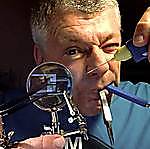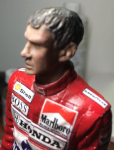Hi Mal
Oh wow, there's more? Now I have to take a look in the packets that are so carefully stowed away. Thanks doesn't sound enough.
I was wondering about the seat too. I found some reference pics where the sides appear to be painted and others where it is, as you say, all the red/brown.
Here's a link to the one I drew inspiration from, but you prompted me to read the text properly and it's from a later model. Looks like I need to do a little repainting.
http://www.britmodeller.com/forums/index.php?/topic/55995-spitfire-seat-colour/
As always thanks a million for all your advice and even presents.
Oh, and yes, Swiss post-persons are very literal. I had a package returned once because my name was spelt with a 'v'.
Keep calm and model on.
Steve
Hosted by Rowan Baylis
Spitfire Vb by Hobby Boss in 1/32 scale

SteveAndrews

Joined: August 16, 2010
KitMaker: 693 posts
AeroScale: 551 posts

Posted: Tuesday, March 07, 2017 - 05:43 PM UTC
Posted: Wednesday, March 08, 2017 - 12:40 PM UTC
Yep, chack out the wing walk package and the main one 
Yep, that seat is clearly from a restored aircraft, you can tell by the seat belt. And you can see that the side frames have been painted over. As Edgar says in the threads, the seat was metal until mid(?) 1940. I am building a 1/48 version of a Mk I in Geoffrey Wellum's markings, K9998, which was the 211th built out of the first batch of 212. It had a metal seat, pole antenna and pump up undercarriage and no IFF wires but had been fitted with the 3 bladed prop and armoured wind screen.I know this because I have asked the man himself about it. Oh and it had a red crowbar in the door
Out of interest I have also spoken to Mr Wellum about how he was dress on the walk to this Spitfire for the very first time, see his book "First Light" page 101-102 This information, and that of the ground crew, is being used to create figures for A 1/32 scale Diorama
This information, and that of the ground crew, is being used to create figures for A 1/32 scale Diorama 

Yep, that seat is clearly from a restored aircraft, you can tell by the seat belt. And you can see that the side frames have been painted over. As Edgar says in the threads, the seat was metal until mid(?) 1940. I am building a 1/48 version of a Mk I in Geoffrey Wellum's markings, K9998, which was the 211th built out of the first batch of 212. It had a metal seat, pole antenna and pump up undercarriage and no IFF wires but had been fitted with the 3 bladed prop and armoured wind screen.I know this because I have asked the man himself about it. Oh and it had a red crowbar in the door

Out of interest I have also spoken to Mr Wellum about how he was dress on the walk to this Spitfire for the very first time, see his book "First Light" page 101-102
 This information, and that of the ground crew, is being used to create figures for A 1/32 scale Diorama
This information, and that of the ground crew, is being used to create figures for A 1/32 scale Diorama 

SteveAndrews

Joined: August 16, 2010
KitMaker: 693 posts
AeroScale: 551 posts

Posted: Thursday, March 09, 2017 - 03:14 AM UTC
Hi Mal
So I excitedly delved into the packets you sent me, and it seems like I have mask for just about every decal and the wing leading edges. I'm flabbergasted and very grateful.
It crossed my mind to make a diorama too. Have you found some good 1/32 figures? I've found pilots but not so many others.
In the meantime, I'm making slow but steady progress.
Thanks again for all your help and for sharing your wealth of knowledge
Steve
So I excitedly delved into the packets you sent me, and it seems like I have mask for just about every decal and the wing leading edges. I'm flabbergasted and very grateful.
It crossed my mind to make a diorama too. Have you found some good 1/32 figures? I've found pilots but not so many others.
In the meantime, I'm making slow but steady progress.
Thanks again for all your help and for sharing your wealth of knowledge
Steve

SteveAndrews

Joined: August 16, 2010
KitMaker: 693 posts
AeroScale: 551 posts

Posted: Thursday, March 09, 2017 - 03:16 AM UTC
Modelling, like just about every other aspect of life, has its standard operating procedures. The standard operating procedure for painting cockpits it to apply a base colour, then apply a wash and finally dry brush to pick out highlights. Thatís fair enough and it gives a pleasing result. But, hereís the thing, I like to be different. Itís always been a weakness - or strength - depending on my own mood and who you ask. Ask my ex-wife and youíll come to understand it is almost as heinous as eating meat.
I must admit Iíve never quite liked the idea that one type of vehicle needs itís own distinct set of techniques. Tanks get chipped paint, but so do aircraft and ships. Light bounces off a painted wing in the same way it bounces off painted armour plate. Dust collects on a parked aircraft as well as a parked car, etc.
So, my approach to painting the interior - most of which wonít be see - has been to combine some techniques. Thereís a bit of colour modulation and use of pastels taken from the armour school, a bit of highlighting and shadow taken from the figure painting school, and yes some dry brushing too. Check it out and see which techniques you can spot. Itís not done yet, and my bright lights are masking some of the subtleties so Iíll try for some shots in day light as I progress.
Keep calm and experiment.
Steve



I must admit Iíve never quite liked the idea that one type of vehicle needs itís own distinct set of techniques. Tanks get chipped paint, but so do aircraft and ships. Light bounces off a painted wing in the same way it bounces off painted armour plate. Dust collects on a parked aircraft as well as a parked car, etc.
So, my approach to painting the interior - most of which wonít be see - has been to combine some techniques. Thereís a bit of colour modulation and use of pastels taken from the armour school, a bit of highlighting and shadow taken from the figure painting school, and yes some dry brushing too. Check it out and see which techniques you can spot. Itís not done yet, and my bright lights are masking some of the subtleties so Iíll try for some shots in day light as I progress.
Keep calm and experiment.
Steve



thegirl

Joined: January 19, 2008
KitMaker: 6,743 posts
AeroScale: 6,151 posts

Posted: Thursday, March 09, 2017 - 05:13 AM UTC
I like it , very eye catching .
terri
terri
Posted: Thursday, March 09, 2017 - 12:32 PM UTC
The national marking set is in there so that you can compare it to the ones that you have, for my interest as much as anything else. I'm guessing that those that you have are cut in Oramask 810 (look on the back of the backing sheet?). Notice that my vinyl has nothing printed on the back of the backing paper, because its Top Secret!  And better a than Oramask 810!
And better a than Oramask 810! 
I too like to do things a little differently but not so much these days in the cockpit as I tend to have the cockpit closed. I'm more interested in the markings rather than the cockpit, well that's my excuse! One thing that I do that no one else seems to is to paint the instrument bezels gloss black rather than dry brushing them or painting them in grey. This highlights them more realistically. Well it looks more realistic. The Spanish modulation thing is not for me, too cartoony! Although it does sort of work or, more accurately, the method is excepted as "the bees knees" in techniques? Which is why I don't use it, much the same as "black basing", which to me is just nonsense (possibly because I cannot get my head around how it is supposed to work and even when I see it done by "experts" in the technique I just can't see any benefits to the long laborious process. So for the time being, until I find a better way, I will stick to my "White basing, pre-shading, post shaded" (WBPSPS) technique. Apparently you have to name your technique
One thing that I do that no one else seems to is to paint the instrument bezels gloss black rather than dry brushing them or painting them in grey. This highlights them more realistically. Well it looks more realistic. The Spanish modulation thing is not for me, too cartoony! Although it does sort of work or, more accurately, the method is excepted as "the bees knees" in techniques? Which is why I don't use it, much the same as "black basing", which to me is just nonsense (possibly because I cannot get my head around how it is supposed to work and even when I see it done by "experts" in the technique I just can't see any benefits to the long laborious process. So for the time being, until I find a better way, I will stick to my "White basing, pre-shading, post shaded" (WBPSPS) technique. Apparently you have to name your technique 
Having said that, I have bought some water colour pencils to have a go at a technique using them.
 And better a than Oramask 810!
And better a than Oramask 810! 
I too like to do things a little differently but not so much these days in the cockpit as I tend to have the cockpit closed. I'm more interested in the markings rather than the cockpit, well that's my excuse!
 One thing that I do that no one else seems to is to paint the instrument bezels gloss black rather than dry brushing them or painting them in grey. This highlights them more realistically. Well it looks more realistic. The Spanish modulation thing is not for me, too cartoony! Although it does sort of work or, more accurately, the method is excepted as "the bees knees" in techniques? Which is why I don't use it, much the same as "black basing", which to me is just nonsense (possibly because I cannot get my head around how it is supposed to work and even when I see it done by "experts" in the technique I just can't see any benefits to the long laborious process. So for the time being, until I find a better way, I will stick to my "White basing, pre-shading, post shaded" (WBPSPS) technique. Apparently you have to name your technique
One thing that I do that no one else seems to is to paint the instrument bezels gloss black rather than dry brushing them or painting them in grey. This highlights them more realistically. Well it looks more realistic. The Spanish modulation thing is not for me, too cartoony! Although it does sort of work or, more accurately, the method is excepted as "the bees knees" in techniques? Which is why I don't use it, much the same as "black basing", which to me is just nonsense (possibly because I cannot get my head around how it is supposed to work and even when I see it done by "experts" in the technique I just can't see any benefits to the long laborious process. So for the time being, until I find a better way, I will stick to my "White basing, pre-shading, post shaded" (WBPSPS) technique. Apparently you have to name your technique 
Having said that, I have bought some water colour pencils to have a go at a technique using them.

SteveAndrews

Joined: August 16, 2010
KitMaker: 693 posts
AeroScale: 551 posts

Posted: Thursday, March 09, 2017 - 05:24 PM UTC
Hi Terri and Mal
Terri thanks for dropping in again. Eye catching is the desired result especially as so much of it will be hidden. It needs to pop.
Mal, I like your style - go your own way and do your own thing. These days we are spoilt for techniques and products so I guess its all about choosing the products you like and getting to a satisfying level of skill with the techniques.
Yes of course - the roundels! You know, I'd forgotten exactly what I asked for - you've given me so much. When I get to painting the exterior I'll do more of a share and compare with the Pmasks set I bought. I've had a quick look at yours and they seem beautifully cut - precise and clean.
More soon.
S
Terri thanks for dropping in again. Eye catching is the desired result especially as so much of it will be hidden. It needs to pop.
Mal, I like your style - go your own way and do your own thing. These days we are spoilt for techniques and products so I guess its all about choosing the products you like and getting to a satisfying level of skill with the techniques.
Yes of course - the roundels! You know, I'd forgotten exactly what I asked for - you've given me so much. When I get to painting the exterior I'll do more of a share and compare with the Pmasks set I bought. I've had a quick look at yours and they seem beautifully cut - precise and clean.
More soon.
S

SpeedyJ

Joined: September 17, 2013
KitMaker: 1,617 posts
AeroScale: 212 posts

Posted: Thursday, March 09, 2017 - 06:36 PM UTC
"White basing, pre-shading, post shaded" (WBPSPS) technique. Apparently you have to name your technique 
Having said that, I have bought some water colour pencils to have a go at a technique using them.[/quote]
Like it those comments. YCNDTOSA. You Can Not Do That On Stage Anymore
FZ Volume 1 up to 6.
Yahoozna,
Robert Jan

Having said that, I have bought some water colour pencils to have a go at a technique using them.[/quote]
Like it those comments. YCNDTOSA. You Can Not Do That On Stage Anymore
FZ Volume 1 up to 6.
Yahoozna,
Robert Jan
KelticKnot

Joined: May 11, 2015
KitMaker: 768 posts
AeroScale: 656 posts

Posted: Saturday, March 11, 2017 - 02:24 PM UTC
Steve, I'm liking where you're going with the colour modulation technique.
I've seen a few examples where it seems overdone and the subject begins to look like comic art but used sympathetically it can really enhance the illusion of scale and natural light.
I've seen a few examples where it seems overdone and the subject begins to look like comic art but used sympathetically it can really enhance the illusion of scale and natural light.

SteveAndrews

Joined: August 16, 2010
KitMaker: 693 posts
AeroScale: 551 posts

Posted: Monday, March 13, 2017 - 02:20 AM UTC
Hi guys
Well I guess we'll call this one MIUAYGA - make it up as you go along. Thanks for looking in, and for your patience. Its slow going right now as that old nemesis life gets in the way. I have a feeling that once the fuselage halves are together then most of this work will be lost, but we'll see.
By the way Mal, you asked me about the Pmasks; they are printed on Oramask 810.
Keep calm and paint as you want to.
Steve
Well I guess we'll call this one MIUAYGA - make it up as you go along. Thanks for looking in, and for your patience. Its slow going right now as that old nemesis life gets in the way. I have a feeling that once the fuselage halves are together then most of this work will be lost, but we'll see.
By the way Mal, you asked me about the Pmasks; they are printed on Oramask 810.
Keep calm and paint as you want to.
Steve
Posted: Monday, March 13, 2017 - 12:13 PM UTC
MIUAYGA, I like the sound of that as that is how I still feel after being out of modelling for about 5 years and really only being back at the bench on a regular basis this year! I had felt that I didn't really know what I was doing, all my previous methods seemed to have left me! That makes life difficult and MIUAYGA is what I feel that I do 
My worst fears confirmed! I still have a 50m roll of this stuff since I found out its major drawback; it shrinks back, badly, at the cut line. Makatar Masks explain this on their web site.

Quoted Text
By the way Mal, you asked me about the Pmasks; they are printed on Oramask 810.
My worst fears confirmed! I still have a 50m roll of this stuff since I found out its major drawback; it shrinks back, badly, at the cut line. Makatar Masks explain this on their web site.

SteveAndrews

Joined: August 16, 2010
KitMaker: 693 posts
AeroScale: 551 posts

Posted: Monday, March 13, 2017 - 05:16 PM UTC
Hi Mal
Hang in there with the techniques. The path to modelling Nirvana is out there somewhere.
Your absolutely tight about the shrinkage. There's a noticeable gap between different mask elements in my Pmasks set, whereas I have to look hard to find the edges on yours. Sorry to read about the big roll of old stuff you have. Anyone got ideas to help Mal out?
Keep calm and try stuff out.
Steve.
Hang in there with the techniques. The path to modelling Nirvana is out there somewhere.
Your absolutely tight about the shrinkage. There's a noticeable gap between different mask elements in my Pmasks set, whereas I have to look hard to find the edges on yours. Sorry to read about the big roll of old stuff you have. Anyone got ideas to help Mal out?
Keep calm and try stuff out.
Steve.
Posted: Tuesday, March 14, 2017 - 12:12 PM UTC
Quoted Text
Hang in there with the techniques. The path to modelling Nirvana is out there somewhere.
Ha ha
 I'm not sure that I'm trying to find "modelling Nirvana" I'm fairly happy with what I produce I just wish it was relatively easy to do, again!
I'm not sure that I'm trying to find "modelling Nirvana" I'm fairly happy with what I produce I just wish it was relatively easy to do, again! 
Quoted Text
Your absolutely tight about the shrinkage. There's a noticeable gap between different mask elements in my Pmasks set, whereas I have to look hard to find the edges on yours. Sorry to read about the big roll of old stuff you have. Anyone got ideas to help Mal out?
When I first found Oramask 810 I thought that I had found gold. I had tried other material but I was getting reports of that stuff leaving a residue which was impossible to remove. I found another material but could only get it in 10m rolls so it worked out really expensive, £46 per roll. At first that wasn't a major problem but later when I met Alex Glass (Uschi van der Rosten) and we discussed disc camo for German WWII armour I knew that I need something much cheap, and found Oramask, at £80 per 50m roll! He put me onto AK interactive who wanted the Disc camo and they had hundreds off me. But the first time that I cut a set of masks for an RAF subject I realised that there was a problem. The disc camo is thousands of very small elements so the problem doesn't present itself. The day after cutting the RAF masks I went into the man cave to package them up and saw the problem! I re-cut them in my normal material, saddened that I was back to paying £46 per 10m but very happy that I had a solution to the problem

After a few more rolls at £46 I phoned the company that I bought it off and they said that they could supply me with 50m rolls but the cost would be £180!+ P&P (that was only a tenner
 ) I wasn't happy paying £180 but it was better then 5 at £46 (£230). I needed to contact the sales manager each time for this "deal" and when I ordered a 4th it had a sticker inside the roll and I phoned the company to find out that they actually supplied it it the company that I had been buying it off and to buy a 50m roll off them would only cost me £83! Get in
) I wasn't happy paying £180 but it was better then 5 at £46 (£230). I needed to contact the sales manager each time for this "deal" and when I ordered a 4th it had a sticker inside the roll and I phoned the company to find out that they actually supplied it it the company that I had been buying it off and to buy a 50m roll off them would only cost me £83! Get in  So you can see why the material that I use is "Top Secret"
So you can see why the material that I use is "Top Secret" 
I do still use the Oramask 810 for things like camouflage masks because this shrink back doesn't matter with that sort of thing. However I often can't be bothered to change the roll just for the camo masks when I do a set, such as what I did for you!

Just to add I don't do anything for AK anymore but I do still do stuff for Uschi van der Rosten and Hypersonic models
The only other mask producing company that I know of that has acknowledged also addressed this shrink back problem is "Maketar" and they use "Kubaki", or more properly "Washi" tape. This has its own advantages and disadvantages but I do believe that my solution works best as it address the problem without any of the disadvantages but, of course, I would say that
 My point is though that this must be a known problem but only 2 companies have bothered to find a solution!
My point is though that this must be a known problem but only 2 companies have bothered to find a solution!
SteveAndrews

Joined: August 16, 2010
KitMaker: 693 posts
AeroScale: 551 posts

Posted: Thursday, March 16, 2017 - 12:57 AM UTC
Hi Mal
You're a true entrepreneur. More power to your secret formula, it definitely produces a better product. I'm slowly getting closer to the point where I might actually use some instead of talking about them. There's some beautiful products made by the companies you work with too.
I'm learning all sorts from you, and thanks very much for sharing it.
Have a great evening.
Steve
You're a true entrepreneur. More power to your secret formula, it definitely produces a better product. I'm slowly getting closer to the point where I might actually use some instead of talking about them. There's some beautiful products made by the companies you work with too.
I'm learning all sorts from you, and thanks very much for sharing it.
Have a great evening.
Steve

SteveAndrews

Joined: August 16, 2010
KitMaker: 693 posts
AeroScale: 551 posts

Posted: Thursday, March 16, 2017 - 12:59 AM UTC
Ladies and gentlemen, roll-up roll-up for the great detail disappearing trick. Gasp as hours of careful painting vanish. Thrill as weathering appears to dissolve before your eyes, and marvel as entire parts are engulfed by murky shadows. Yes, its time to close the fuselage halves.
I fall into the same trap every time I build an aircraft; loads of work goes into an area of the kit that barely shows. I wonder why we get so obsessed with cockpits, they must form about 5 per cent or so of an aircraftís visual appeal once its finished, and yet we (OK, I) spend ages on them. I guess that detail is irresistible to us detail junkies.
So, here we have the finished article in all its glory, plus what remains to be seen when the fuselage is joined, albeit with tape at this point. You might notice that the instrument panel is devoid of decals in the dials. I dropped in some gloss but thereís no attempt to replicate the dial faces. Its simply because I prefer the look this way. Light reflecting from the gloss paint makes highlights that do a good enough job of simulating some detail, and for me that creates a balanced look with the rest of the cockpit. Sometimes less is more, well, in my modelling world at least.







I fall into the same trap every time I build an aircraft; loads of work goes into an area of the kit that barely shows. I wonder why we get so obsessed with cockpits, they must form about 5 per cent or so of an aircraftís visual appeal once its finished, and yet we (OK, I) spend ages on them. I guess that detail is irresistible to us detail junkies.
So, here we have the finished article in all its glory, plus what remains to be seen when the fuselage is joined, albeit with tape at this point. You might notice that the instrument panel is devoid of decals in the dials. I dropped in some gloss but thereís no attempt to replicate the dial faces. Its simply because I prefer the look this way. Light reflecting from the gloss paint makes highlights that do a good enough job of simulating some detail, and for me that creates a balanced look with the rest of the cockpit. Sometimes less is more, well, in my modelling world at least.







Posted: Thursday, March 16, 2017 - 11:45 AM UTC
Quoted Text
Hi Mal
You're a true entrepreneur. More power to your secret formula, it definitely produces a better product. I'm slowly getting closer to the point where I might actually use some instead of talking about them. There's some beautiful products made by the companies you work with too.
I'm learning all sorts from you, and thanks very much for sharing it.
Have a great evening.
Steve
I don't know about being an entrepreneur I just do the best that I can
 I'm more than happy to share and another little thing is that the gun button and its housing were unpainted brass.
I'm more than happy to share and another little thing is that the gun button and its housing were unpainted brass.I'm sort of with you on the dials although I do add them along with seat belts as the minimum that I add and if it's a fairly well detailed cockipit that is all I will add because, as you say, added detail will be all but hidden. I have had success scratching the dial detail into the bezels and then glossing them. You can bet that anyone not knowing that you haven't added decals for the dials will see them anyway!


SteveAndrews

Joined: August 16, 2010
KitMaker: 693 posts
AeroScale: 551 posts

Posted: Monday, March 20, 2017 - 02:05 AM UTC
Mal, its guys like you who share their knowledge and expertise that keep our hobby moving forward, so thanks again for all your interest in this build. I'll do a touch up on the gun button, but for now its onwards with construction...
Keep calm and research your subject!
S
Keep calm and research your subject!
S

SteveAndrews

Joined: August 16, 2010
KitMaker: 693 posts
AeroScale: 551 posts

Posted: Monday, March 20, 2017 - 02:12 AM UTC
With the interior complete, the next job is joining the fuselage halves. This is drama free, and with a little coaxing the fit is eventually good. Just a little filler will be needed and then some re-scribing and re-riveting. That job would be needed anyway because the detail runs out near the edges of the moulds. Hereís how she looked before

and after




and after




SteveAndrews

Joined: August 16, 2010
KitMaker: 693 posts
AeroScale: 551 posts

Posted: Monday, March 20, 2017 - 10:04 PM UTC
Now the glue is dry, its time to check for gaps. I picked up the technique described here from the Plasmo channel (I think). All you do is run a highlighter or marker pen along the seam and then sand over it. The sanding removes most of the marker leaving it only in recesses. Et voila, now you can see if filler is needed.
At the same time, I set about correcting the area in front of the cockpit. It is moulded to receive the exterior armoured glass, but the version Iím modelling doesn't have it. Thereís a lip and a slot to sort out. I scraped and sanded away the lip, and roughly cut a shape from plastic sheet to fill the slot. Once the glue has dried Iíll sand the plastic card to match the curve of the fuselage.
While I had the card out I also made a small shape to cover the gap left by the landing lights that I wont be fitting. I did this by white gluing the part to a piece of plastic card and then cutting and sanding until the profile of the two parts matched.
By the way, Hobby Boss provide transparent covers for the wing machine gun and cannon bays. Thatís not a problem but it does make ensuring a good fit just a bit more difficult. It hard to tell if pieces are aligned. I lightly sanded them in an attempt to see better but even so it was only after Iíd assembled the parts that I noticed a slight bulge. They are a tight fit and I guess the pressure pushed two parts up after gluing. Itís not too bad and well within the realms of what I can happily tell myself is reminiscent of wear and tear on the real thing. Even so, having learnt my lesson on one side I was more careful with the other. Test twice, fit once, right?
Why is this so much fun? I have no idea, but I find it all deeply satisfying.
Have fun with plastic folks.





At the same time, I set about correcting the area in front of the cockpit. It is moulded to receive the exterior armoured glass, but the version Iím modelling doesn't have it. Thereís a lip and a slot to sort out. I scraped and sanded away the lip, and roughly cut a shape from plastic sheet to fill the slot. Once the glue has dried Iíll sand the plastic card to match the curve of the fuselage.
While I had the card out I also made a small shape to cover the gap left by the landing lights that I wont be fitting. I did this by white gluing the part to a piece of plastic card and then cutting and sanding until the profile of the two parts matched.
By the way, Hobby Boss provide transparent covers for the wing machine gun and cannon bays. Thatís not a problem but it does make ensuring a good fit just a bit more difficult. It hard to tell if pieces are aligned. I lightly sanded them in an attempt to see better but even so it was only after Iíd assembled the parts that I noticed a slight bulge. They are a tight fit and I guess the pressure pushed two parts up after gluing. Itís not too bad and well within the realms of what I can happily tell myself is reminiscent of wear and tear on the real thing. Even so, having learnt my lesson on one side I was more careful with the other. Test twice, fit once, right?
Why is this so much fun? I have no idea, but I find it all deeply satisfying.
Have fun with plastic folks.





Posted: Tuesday, March 21, 2017 - 11:55 AM UTC
Yes that's a good idea with the marker. Spencer Pollard highlighted this idea on his blogg and a particular colour and type of marker sold out over most outlets! From what I understand though you have to be careful with the type of marker as, with some, any ink left will bleed through any and every paint layer! The one that Spencer recommended was the ZIG Kurecolor (Alcoholbased Dyestuff Ink). I guess the important part is that its alcohol based? Anyway its a good tip and works 
Nicely done with the bits and pieces. I had a look to see if I had any photos to show what I did but no, I can't find any. I did pretty much the same as you though

Nicely done with the bits and pieces. I had a look to see if I had any photos to show what I did but no, I can't find any. I did pretty much the same as you though


SteveAndrews

Joined: August 16, 2010
KitMaker: 693 posts
AeroScale: 551 posts

Posted: Sunday, March 26, 2017 - 11:20 PM UTC
Hi Mal
Blimey, has it been a week since I last posted? I've been laid low with what my doctor described as Scarlett Fever. If that sounds improbable here in the land of healthy living and more snow than palm trees, well I thought so too until one day it took every ounce of energy I had just to get up for a glass of water.
Well those little visitors are mostly seen off now, so I can do fun things again. Hello Spitfire, remember me?
Yes, I'm sure you're right about the origin of the market technique and you're definitely right about being careful of show through. The sanding gets rid of most of it and anything that's left can be removed with lacquer thinner. At least that worked on the marker pen I used.
So here's what's been happening...
Blimey, has it been a week since I last posted? I've been laid low with what my doctor described as Scarlett Fever. If that sounds improbable here in the land of healthy living and more snow than palm trees, well I thought so too until one day it took every ounce of energy I had just to get up for a glass of water.
Well those little visitors are mostly seen off now, so I can do fun things again. Hello Spitfire, remember me?
Yes, I'm sure you're right about the origin of the market technique and you're definitely right about being careful of show through. The sanding gets rid of most of it and anything that's left can be removed with lacquer thinner. At least that worked on the marker pen I used.
So here's what's been happening...

SteveAndrews

Joined: August 16, 2010
KitMaker: 693 posts
AeroScale: 551 posts

Posted: Sunday, March 26, 2017 - 11:33 PM UTC
Big kits mean big assemblies and big fun. Having been away from the Spití for nearly a week (see above), I really felt like getting on with it so I jumped into joining the wing halves. The fit is not too bad and with the help of plenty of glue and that nice yellow tape made by Mr Tamiya, the wings join well. There are no gaps but assembly does leave a bit of a lip on leading and trailing edges. Those will need some attention once the glue is dry.
Having satisfied my self with this job I remembered my plan to paint the wheel bays before assembly. Bugger. I also remembered why. Thereís nothing behind the slots where the landing legs retract except air and upper wing surface. Getting an airbrush in there will be difficult. I might need to brush paint or scratch some of the detail present on the real aircraft. Time to check references and make a new plan.




Having satisfied my self with this job I remembered my plan to paint the wheel bays before assembly. Bugger. I also remembered why. Thereís nothing behind the slots where the landing legs retract except air and upper wing surface. Getting an airbrush in there will be difficult. I might need to brush paint or scratch some of the detail present on the real aircraft. Time to check references and make a new plan.




Posted: Monday, March 27, 2017 - 11:52 AM UTC
I hope that you aren't going to lower the flaps? Flaps on the Spitfire were used for one thing, landing. So they were either up or down and on landing the S.O.P (Standard operating procedure) was to raise them ASAP, to prevent damage. Apparently Pilots were fined if they didn't raise them! The only time that you would find them lowered when static is for maintenance.
When Spitfires had to fly off carriers to get to Malta they needed part flap to ensure that they could do so with the large ferry tank on. To achieve this the flaps were lowered and wooden wedges were held in place while the flaps were raised, trapping them and holding the flaps at the required angle. After lift off the flaps would simply be lowered, the wedges fell out and the flaps raised This is mentioned by Geoffry Wellum in his fantastic book, "First Light".
This is mentioned by Geoffry Wellum in his fantastic book, "First Light".
When Spitfires had to fly off carriers to get to Malta they needed part flap to ensure that they could do so with the large ferry tank on. To achieve this the flaps were lowered and wooden wedges were held in place while the flaps were raised, trapping them and holding the flaps at the required angle. After lift off the flaps would simply be lowered, the wedges fell out and the flaps raised
 This is mentioned by Geoffry Wellum in his fantastic book, "First Light".
This is mentioned by Geoffry Wellum in his fantastic book, "First Light".
SteveAndrews

Joined: August 16, 2010
KitMaker: 693 posts
AeroScale: 551 posts

Posted: Monday, March 27, 2017 - 04:03 PM UTC
Hi Mal
Top advice, and no, the flaps will be up. I just haven't fitted them yet in the shots I took. All my references agree with you of course so this one is an easy choice.
With thanks as always.
Steve
Top advice, and no, the flaps will be up. I just haven't fitted them yet in the shots I took. All my references agree with you of course so this one is an easy choice.
With thanks as always.
Steve

SteveAndrews

Joined: August 16, 2010
KitMaker: 693 posts
AeroScale: 551 posts

Posted: Sunday, April 23, 2017 - 09:55 PM UTC
Hello Ladies and Gents
Its been a while since I have posted, and its going to be a while longer I'm afraid.
The triple whammy of being a part-time-single-dad, travel for work and another project means I am putting this one on hold for a little while. Its not gone or forgotten, just parked.
If you've been following the build then I'm sorry to stop the fun for a while, and especially sorry to Mal who won't see the fruits of his labours just yet.
In the meantime I hope you have enjoyed the blog so far and are ready for more when work resumes.
With best wishes.
Steve
Its been a while since I have posted, and its going to be a while longer I'm afraid.
The triple whammy of being a part-time-single-dad, travel for work and another project means I am putting this one on hold for a little while. Its not gone or forgotten, just parked.
If you've been following the build then I'm sorry to stop the fun for a while, and especially sorry to Mal who won't see the fruits of his labours just yet.
In the meantime I hope you have enjoyed the blog so far and are ready for more when work resumes.
With best wishes.
Steve
 |











